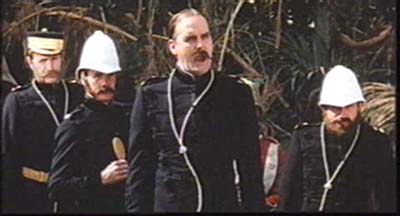A survivor of the crushing Battle of Tsushima during the Russo-Japanese war in 1905, the Russian light cruiser Zhemchug remained in the Pacific Ocean to show the flag of the Tsar in the warm waters of that region. When World War One erupted in 1914 the 3,100-ton Zhemchugtook part in early convoy operations in the Pacific. Her general enemy was the German Pacific squadron of Kaiser Wilhelm II and her particular nemesis was the 3,364- ton German light cruiser Emden. The Emden had separated from the Kaiser's pacific squadron and raided the warm waters far from the European battlefields for months, sinking more than a dozen merchant ships and attacking British colonies. The two ships were well matched on paper; both were relatively new fast ships of a modern design capable of the same speed. The Zhemchug was armed with 8x4.7 inch (120mm) naval guns versus the Emden’s comparable armament of 10x 4.1 inch (105mm) guns.
In her search for the Emden the Zhemchug was brought to the Malaccan Straits where she stalked the Nicobar and Andarman Islands to no avail. Coming up empty handed the Zhemchug put into the Malaysian port of Penang on October 26, 1914. Feeling his ship safe in an allied harbor her Captain, Baron Cherkassov, departed his ship for leave ashore. The good baron left his ship in a deplorable state considering the Emden was thought to be in the region. The ship had no officers on watch as well as no lookouts posted. She was docked to where only one of her guns were able to fire on the harbor entrance, where any enemy would come from, and all of her 120mm ammunition save for a dozen rounds, was locked up. The keys to the ships magazines had been taken ashore with her senior officers for safekeeping. Worse still a number of local prostitutes were taken aboard the ship, further downgrading her crew’s effectiveness.
 |
| Zhemchung memorial in Penang (public domain picture) |
In the predawn hours of October 28, 1914, another cruiser slowly entered the approaches to Penang. It flew the white ensign of the Royal Navy and had altered her appearance to look like the British cruiser HMS Yarmouth. The mysterious cruiser observed the Zhemchug lying at anchor with her lights on and no protective searchlights or torpedo boats around her. The mysterious cruiser in question was in fact the SMS Emden herself. The German cruiser, under the command of Korvettenkapitän Karl von Müller, quietly crept towards her sleeping target who had just days before been hunting for her. At 0515 and a range of just 400m she struck her British flag and ran up the Imperial German naval ensign while fired her torpedo tubes point blank into the Zhemchug. Working up steam the Emden sped past the stricken cruiser, turned sharply and re-engaged her. She raked the decks of the Russian cruiser at a range of just 700m as she passed with every gun capable of firing doing so. A second torpedo from the Emden finished the Zhemchug off, with the stricken ship settling in 30m of water. The unharmed Emden went onto sink a French destroyer also in the harbor and trade shots with the old French cruiser D'Iberville before making good her escape. The Emden, scourge of the Pacific would find itself sunk by the Australian cruiser Sydney less than a fortnight later.
The sinking of the Zhemchug was a traumatic experience for the Russian Pacific Squadron and virtually ended the Russian effort in that ocean during the war. Eighty-nine officers and men were killed and more than a hundred of the survivors were seriously wounded. These figures were very heavy indeed when you consider the Zhemchug complement was 354 men. Eighty-two of the bodies were recovered and interned in western road cemetery in Penang. The remaining crew was returned to Russia on the auxiliary cruiser Orel who had salvaged some of the Zhemchug 120mm guns in December 1914. Captain Baron Cherkassov as well as his second in command, Senior Lieutenant Kulibinu, was arrested on return to Russia. The two disgraced officers were court-martialed for negligence and summarily stripped of all their ranks and privileges as well as being given a 3 year and 18 month prison sentences respectively. Tsar Nicholas II also went so far as to decree that the Baron was to be sentenced to perpetual bachelorhood, it being forbidden for him to marry so that he could not perpetuate his disgraceful family name.
To this day passing Russian ships drop wreaths in the Malaccan Straits and the harbor of Penang to those men of the cruiser Zhemchug. Russians still gather at the monument to the fallen men of the Zhemchug in the western road cemetery at the end of October every year.
Sources
Pleshakov, Constantine The Tsars Last Armada, 2004 Basic Books
Russian Ambassador's Press Releasehttp://www.malaysia.mid.ru/int_e_03.html
Philips, John Spoilers of the Sea: Wartime Raiders in the Age of Steam, 1970
Rickard, J (27 September 2007), Penang Raid, 28 October 1914, http://www.historyofwar.org/articles/raid_penang.html




No comments:
Post a Comment